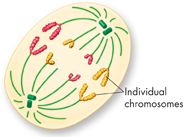Anaphase The third phase of mitosis, anaphase, begins when sister chromatids suddenly separate and begin to move apart. Once anaphase begins, each sister chromatid is now considered an individual chromosome.  During anaphase, the chromosomes separate and move along spindle fibers to opposite ends of the cell. Anaphase comes to an end when this movement stops and the chromosomes are completely separated into two groups.
During anaphase, the chromosomes separate and move along spindle fibers to opposite ends of the cell. Anaphase comes to an end when this movement stops and the chromosomes are completely separated into two groups.
Telophase Following anaphase is telophase, the fourth and final phase of mitosis.  During telophase, the chromosomes, which were distinct and condensed, begin to spread out into a tangle of chromatin. A nuclear envelope re-forms around each cluster of chromosomes. The spindle begins to break apart, and a nucleolus becomes visible in each daughter nucleus. Mitosis is complete. However, the process of cell division has one more step to go.
During telophase, the chromosomes, which were distinct and condensed, begin to spread out into a tangle of chromatin. A nuclear envelope re-forms around each cluster of chromosomes. The spindle begins to break apart, and a nucleolus becomes visible in each daughter nucleus. Mitosis is complete. However, the process of cell division has one more step to go.
 In Your Notebook Create a chart that lists the important information about each phase of mitosis.
In Your Notebook Create a chart that lists the important information about each phase of mitosis.

FIGURE 10–10 Anaphase

FIGURE 10–11 Telophase
Quick Lab
GUIDED INQUIRY
Mitosis in Action 
-
Examine a slide of a stained onion root tip under a microscope. Viewing the slide under low power, adjust the stage until you find the boxlike cells just above the root tip.
-
Switch the microscope to high power and locate cells that are in the process of dividing.
-
Find and sketch cells that are in each phase of mitosis. Label each sketch with the name of the appropriate phase.
Observe In which phase of the cell cycle were most of the cells you observed? Why do you think this is?
Draw Conclusions What evidence did you observe that shows mitosis is a continuous process, not a series of separate events?
Apply Concepts Cells in the root divide many times as the root grows longer and thicker. With each cell division, the chromosomes are divided between two daughter cells, yet the number of chromosomes in each cell does not change. What processes ensure that the normal number of chromosomes is restored after each cell division?
Analyze and Conclude

Table of Contents
- Formulas and Equations
- Applying Formulas and Equations
- Mean, Median, and Mode
- Estimation
- Using Measurements in Calculations
- Effects of Measurement Errors
- Accuracy
- Precision
- Comparing Accuracy and Precision
- Significant Figures
- Calculating With Significant Figures
- Scientific Notation
- Calculating With Scientific Notation
- Dimensional Analysis
- Applying Dimensional Analysis




